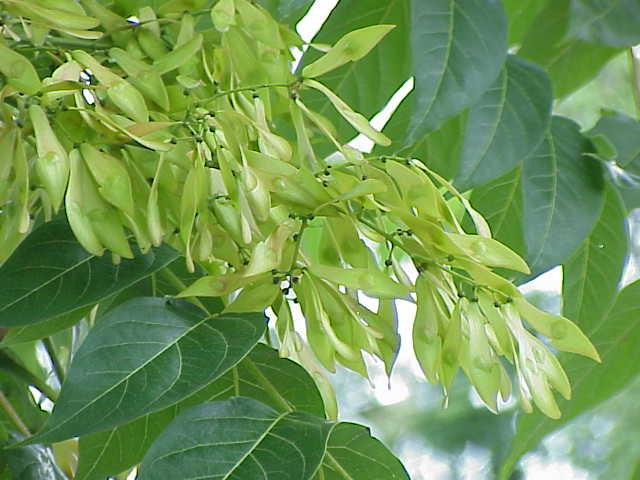- Ailanthus
taxobox
name = "Ailanthus"
image_caption = "Ailanthus altissima" leaf and seeds
regnum =Plantae
unranked_divisio =Angiosperms
unranked_classis =Eudicots
unranked_ordo =Rosids
ordo =Sapindales
familia =Simaroubaceae
genus = "Ailanthus"
genus_authority = Desf.
subdivision_ranks = Species
subdivision = See text|"Ailanthus" (derived from ailanto, an
Ambonese word probably meaning "tree of the gods" or "tree of heaven") is a genus oftree s belonging to the familySimaroubaceae , in the orderSapindales (formerlyRutales orGeraniales ). The genus is native from eastAsia south to northernAustralasia .They are fast-growing
deciduous trees growing to 25-45 m tall, with spreading branches and large (40-100 cm) pinnate leaves with 15-41 long pointed leaflets, the terminal leaflet normally present, and the basal pairs of leaflets often lobed at their bases. The small yellow to greenishflower s are borne on branched panicles they turn reddish later in the year and eventually brown they stay on the tree for a long time; the male flowers have a strong odour. The odour tends to resemble the smell of strong cat urine or the spray of a male cat. Also, touching the leaves leaves an unpleasant smell on the hands. Thefruit is a samara drawn out into a long wing with the seed in the middle. The wood is fine grained and satiny.pecies
The number of species is disputed, with some authorities accepting up to ten species, while others accept six or fewer. Species include:
*"Ailanthus altissima " (Tree of Heaven) – northern and centralmainland China ,Taiwan , arguably the best known species.
*"Ailanthus excelsa " –India andSri Lanka
*"Ailanthus integrifolia " –New Guinea andQueensland ,Australia
*"Ailanthus malabarica " – southeastAsia
*"Ailanthus triphysa " (White Siris) – northern and eastern Australia
*"Ailanthus vilmoriniana " (Downy Tree of Heaven) – southwest ChinaA silk spinning moth, the
Ailanthus moth ("Samia cynthia"), lives on "Ailanthus" leaves, and yields a silk more durable and cheaper than mulberry silk, but inferior to it in fineness and gloss. This moth has been introduced to the eastern United States and is common near many towns; it is about 12 cm across, with angulated wings, and in colour olive brown, with white markings. OtherLepidoptera whoselarva e feed on "Ailanthus" include "Endoclita malabaricus".This is considered an
invasive species in North America. Ailanthus is capable of forming thick blankets of roots and heavy shade to the extent that native species are prevented from being able to reclaim an area that has been logged or deforested, as well as areas that have been heavily developed.Fact|date=June 2008In spite of being an
invasive species on many places, this tree often grows where no others will. Thus it does not replace native species or more desirable trees and may only compete with weeds which have little value.Fact|date=June 2008References and external links
*APNI | name=Ailanthus Desf. | id = 25309
* [http://www.ars-grin.gov/cgi-bin/npgs/html/splist.pl?326 Germplasm Resources Information Network: "Ailanthus"]
Wikimedia Foundation. 2010.
